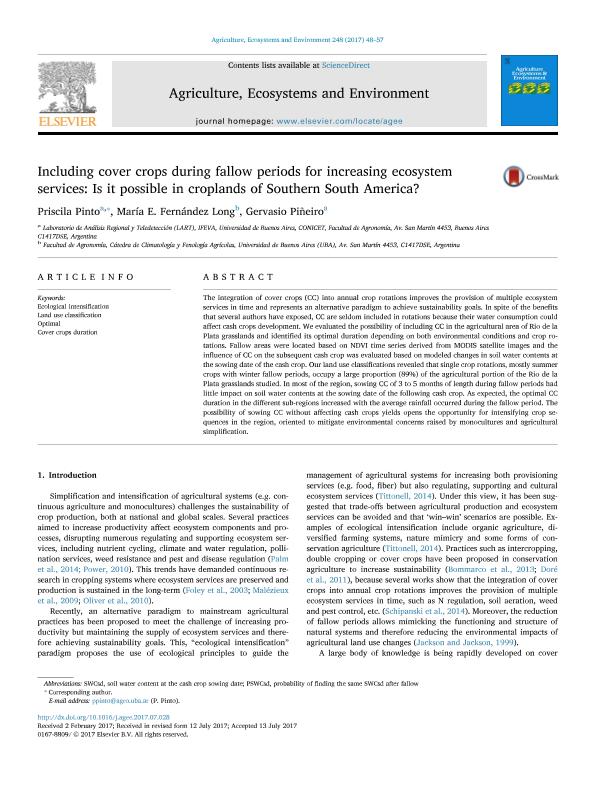Mostrar el registro sencillo del ítem
dc.contributor.author
Pinto, Priscila

dc.contributor.author
Fernández Long, María Elena

dc.contributor.author
Piñeiro, Gervasio

dc.date.available
2018-06-22T15:41:52Z
dc.date.issued
2017-10
dc.identifier.citation
Pinto, Priscila; Fernández Long, María Elena; Piñeiro, Gervasio; Including cover crops during fallow periods for increasing ecosystem services: Is it possible in croplands of Southern South America?; Elsevier Science; Agriculture, Ecosystems and Environment; 248; 10-2017; 48-57
dc.identifier.issn
0167-8809
dc.identifier.uri
http://hdl.handle.net/11336/49647
dc.description.abstract
The integration of cover crops (CC) into annual crop rotations improves the provision of multiple ecosystem services in time and represents an alternative paradigm to achieve sustainability goals. In spite of the benefits that several authors have exposed, CC are seldom included in rotations because their water consumption could affect cash crops development. We evaluated the possibility of including CC in the agricultural area of Rio de la Plata grasslands and identified its optimal duration depending on both environmental conditions and crop rotations. Fallow areas were located based on NDVI time series derived from MODIS satellite images and the influence of CC on the subsequent cash crop was evaluated based on modeled changes in soil water contents at the sowing date of the cash crop. Our land use classifications revealed that single crop rotations, mostly summer crops with winter fallow periods, occupy a large proportion (89%) of the agricultural portion of the Rio de la Plata grasslands studied. In most of the region, sowing CC of 3 to 5 months of length during fallow periods had little impact on soil water contents at the sowing date of the following cash crop. As expected, the optimal CC duration in the different sub-regions increased with the average rainfall occurred during the fallow period. The possibility of sowing CC without affecting cash crops yields opens the opportunity for intensifying crop sequences in the region, oriented to mitigate environmental concerns raised by monocultures and agricultural simplification.
dc.format
application/pdf
dc.language.iso
eng
dc.publisher
Elsevier Science

dc.rights
info:eu-repo/semantics/openAccess
dc.rights.uri
https://creativecommons.org/licenses/by-nc-sa/2.5/ar/
dc.subject
Cover Crops Duration
dc.subject
Ecological Intensification
dc.subject
Land Use Classification
dc.subject
Optimal
dc.subject.classification
Meteorología y Ciencias Atmosféricas

dc.subject.classification
Ciencias de la Tierra y relacionadas con el Medio Ambiente

dc.subject.classification
CIENCIAS NATURALES Y EXACTAS

dc.title
Including cover crops during fallow periods for increasing ecosystem services: Is it possible in croplands of Southern South America?
dc.type
info:eu-repo/semantics/article
dc.type
info:ar-repo/semantics/artículo
dc.type
info:eu-repo/semantics/publishedVersion
dc.date.updated
2018-06-19T15:55:52Z
dc.identifier.eissn
1873-2305
dc.journal.volume
248
dc.journal.pagination
48-57
dc.journal.pais
Países Bajos

dc.journal.ciudad
Amsterdam
dc.description.fil
Fil: Pinto, Priscila. Consejo Nacional de Investigaciones Científicas y Técnicas. Oficina de Coordinación Administrativa Parque Centenario. Instituto de Investigaciones Fisiológicas y Ecológicas Vinculadas a la Agricultura. Universidad de Buenos Aires. Facultad de Agronomía. Instituto de Investigaciones Fisiológicas y Ecológicas Vinculadas a la Agricultura; Argentina
dc.description.fil
Fil: Fernández Long, María Elena. Universidad Nacional de Río Cuarto. Facultad de Agronomía y Veterinaria. Cátedra de Climatología y Fenología Agrícolas; Argentina
dc.description.fil
Fil: Piñeiro, Gervasio. Consejo Nacional de Investigaciones Científicas y Técnicas. Oficina de Coordinación Administrativa Parque Centenario. Instituto de Investigaciones Fisiológicas y Ecológicas Vinculadas a la Agricultura. Universidad de Buenos Aires. Facultad de Agronomía. Instituto de Investigaciones Fisiológicas y Ecológicas Vinculadas a la Agricultura; Argentina
dc.journal.title
Agriculture, Ecosystems and Environment

dc.relation.alternativeid
info:eu-repo/semantics/altIdentifier/doi/http://dx.doi.org/10.1016/j.agee.2017.07.028
dc.relation.alternativeid
info:eu-repo/semantics/altIdentifier/url/https://www.sciencedirect.com/science/article/pii/S0167880917303146
Archivos asociados
